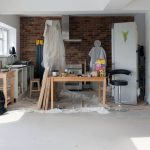The dental industry in the United States has long set world standards – not only in medicine, but also in what a modern clinic should look like. Today, a dental office is not just an office with a chair, but a comfortable, technological and psychologically thoughtful space where the patient feels at ease even before the start of treatment. American clinics invest not only in the latest equipment, but also in creating an environment that heals with trust – through light, colors, architecture and accessibility.
How the philosophy of clinic design is changing
Just two decades ago, most dental offices resembled hospital rooms with bright lamps and the smell of antiseptics. Today, the situation is radically different: light, ergonomics and humanity have replaced coldness and alienation.
American clinics are actively implementing the principle of “inclusive design” – spaces without physical and psychological barriers. The trend is warm colors, natural lighting, thoughtful planning, quiet ventilation, wood elements and soft fabrics. And at the same time – the latest technologies: digital X-rays, automated sterilization centers, interactive panels and software control of equipment. The main idea: human-centricity, when architecture becomes part of the therapy.
Top examples of modern dental offices in the USA
1. Dental Group of Hyattsville – dentist in downtown Hyattsville 20782
(dentalgroupofhyattsville.com)
The clinic is located in the very center of Hyattsville, on the first floor, with a completely barrier-free entrance. This is an example of accessible, inclusive design – wide doors, a spacious lobby, clear zoning. Dental Group of Hyattsville offers a democratic service: accepts Medicaid, works with patients in English and Spanish, accepts without prior appointment. The interior is minimalist – maximum functionality, no overload of details. This is architecture that does not press, but supports.
2. Dental Group of Baltimore – dentist in downtown Baltimore 21201
(baltimorecitydentalgroup.com)
This office is an example of a combination of technology and comfort. Located in the business part of Baltimore, it is focused on active citizens. Bright interiors, thoughtful lighting, flexible working hours. The clinic uses digital diagnostics and modern treatment planning systems, and the main design idea is “the patient is at the center of the space”. The architecture here creates a sense of logic, order and peace.
3. Victory Dental – dentistry in Towson MD 21204
(victorydental.org)
Victory Dental is an example of “home” dentistry. The interior is built on warm colors and natural light, which reduce the tension before the procedure. The clinic team is like a family, and this is felt in everything: from the smiles of the staff to the details of the design. The offices have the latest equipment for minimally invasive procedures, and the general philosophy is “ethical aesthetics”: without pathos, but with care.
4. Center for Fine Dentistry – cosmetic dentist in Maryland
(centerforfinedentistry.com)
This center is a true premium-level aesthetics. Located in the Anne Arundel complex, it combines an artistic approach to dentistry with innovative technologies. The offices are equipped with digital visualization systems, ergonomic chairs and interactive monitors, where patients can even watch movies during treatment. A special pride is the automated sterilization unit. This is a space where sterility does not contradict comfort, but complements it.
5. Dental Group of Essex – dentistry in Baltimore MD 21221
(dentalgroupofessex.com)
The clinic in Essex demonstrates a harmonious combination of technology and home warmth. A cozy waiting area, logical planning, modern equipment – everything to make the patient feel at ease. The team practices a personalized approach and works on the principle of fast, clear communication. The design combines simple lines, natural materials and ergonomics – nothing superfluous, only comfort.
Main trends in US dental design
- Human-centricity: spaces where patient comfort is the main architectural principle.
- Innovation: digital technologies, automation, integration of IT into work.
- Minimalism: clean forms, thoughtful lighting, maximum functionality.
- Inclusivity: universal access, without barriers and discriminatory restrictions.
These approaches are changing not only the appearance of dentistry, but also the culture of medical service in general.
Conclusion
American dental clinics prove: architecture can heal. Technology, design and care for people merge into a single system that creates trust. Ukrainian architects and clinic owners have a lot to draw inspiration from – from organizing barrier-free entrances to psychologically comfortable zoning. The future of dentistry is not only innovative methods, but also spaces where not only teeth are treated, but also feelings.




